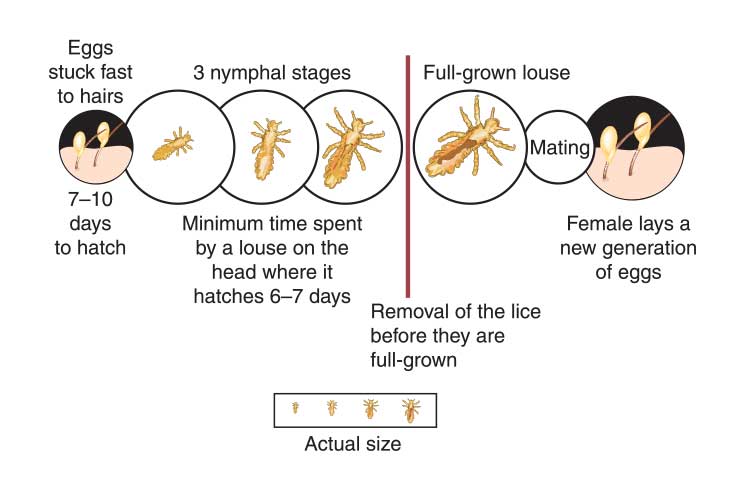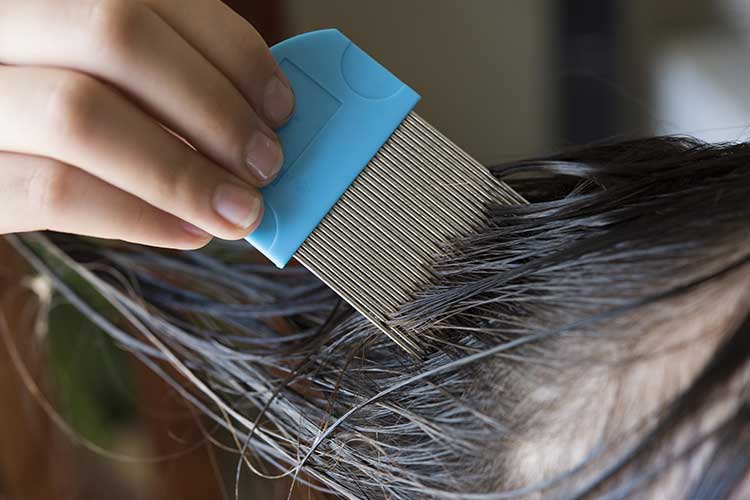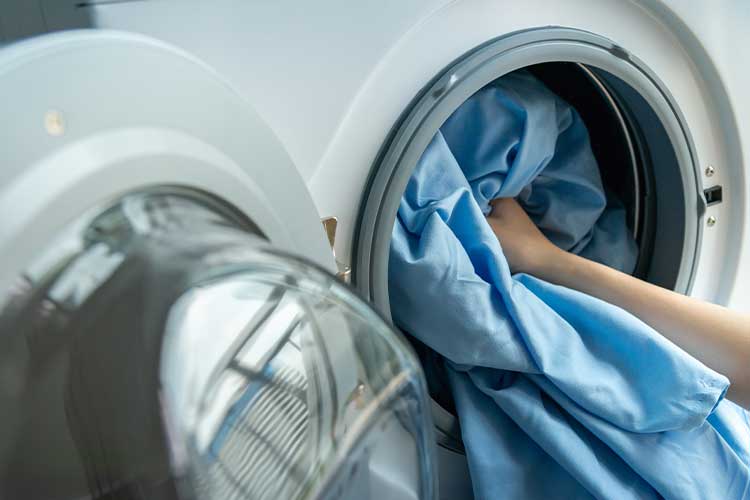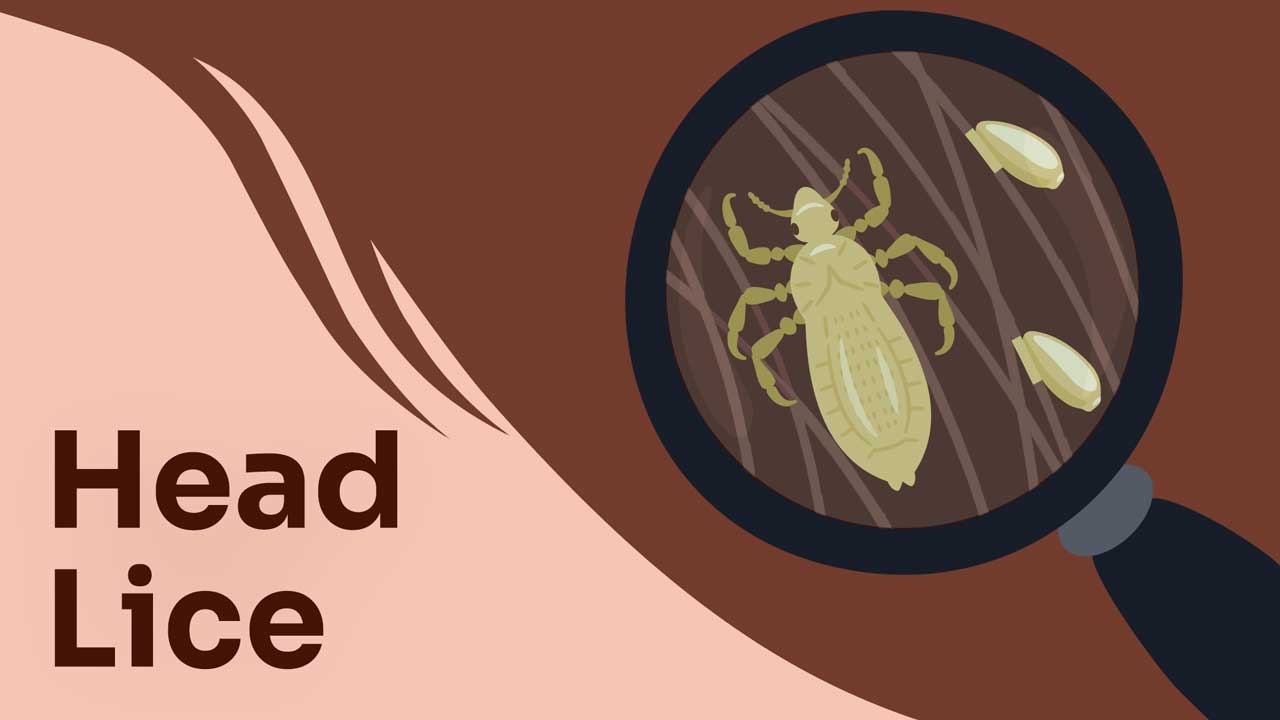If you’ve ever had head lice, you’ll know that they aren’t easy to get rid of. It may not come as a surprise, then, that they’ve managed to exist for millions of years - head lice were even around long before human evolution (Better Health Channel 2023).
What are Head Lice?
Head lice are small, wingless, biting insects that live on, breed in and feed on the human scalp (Better Health Channel 2023).
An adult louse can range from a whitish-brown to reddish-brown colour and is about 2 to 4 millimetres in length. Lice eggs, called ‘nits’, are oblong-shaped, white or brown in colour and attached to hair shafts (SA Health 2022). The warmth from the human head acts as an incubator, causing the nits to hatch (Better Health Channel 2023).
The Life Cycle of Lice
Once a female louse has laid her first eggs on a new host, they will hatch after 7 to 10 days. From here, the nits will progress through their short life cycle consisting of three stages: egg, nymph and adult. The total lifespan of a louse is only 32 to 35 days, but after mating, each female can lay 3 to 10 eggs per day. These eggs will then hatch and continue the cycle (VIC DoH 2015).

Infectious Period
As long as there are living eggs or lice on a person’s head, that individual is infectious to others (SA Health 2022).
How Lice Spread
Lice are transferred between people through direct head-to-head contact. They can not fly or jump but will crawl from one person to another (Better Health Channel 2023).
Lice spread through being in close proximity to others, such as through playing and cuddling, which is why lice most commonly affect children and families (Better Health Channel 2023).
Without a human host, lice can not survive for more than two days (SA Health 2022).
Different species of lice live on animals, but they can not be spread to people or vice versa (SA Health 2022).
Head lice can sometimes be transferred by using or sharing items that someone with lice has recently used. These items may include:
- Combs and brushes
- Hair accessories
- Hats and scarves
- Headphones
- Towels
- Upholstery
- Pillowcases
- Stuffed toys.
(SA Health 2022, Mayo Clinic 2022)
Symptoms of Head Lice
Head lice are commonly associated with itching on the scalp, neck and ears, which is caused by an allergic reaction to louse saliva. However, many people will not experience any itching, and it’s possible to have a lice infestation without knowing (Mayo Clinic 2022; KidsHealth 2023).
Diagnosing and Treating Head Lice

The most effective way to detect and treat lice is to use the conditioner and combing method (Better Health Channel 2023).
These are the steps:
- Make sure hair is dry and detangled.
- Cover all of the hair with conditioner and separate it into sections.
- Thoroughly comb through each section of hair with a fine-toothed lice comb.
- Wipe the comb onto a white tissue and check for lice or nits.
- Comb each section of the head at least four to five times.
- If lice or nits are found, they need to be treated.
(Better Health Channel 2023)
While this method does not kill lice, the conditioner stuns them and allows them to be removed manually (Health NSW 2014)..
The conditioner and combing should be repeated every second to third day until no more lice or nits can be found (Health NSW 2014).
Another method is chemical removal using a treatment that contains insecticides. Chemical treatments need to be repeated because most of them do not kill eggs. Some lice may be resistant to particular active compounds, so chemical treatments do not always work (Health NSW 2014; Better Health Channel 2023).
Note: Any chemical head lice treatment used should have an Australian Registered (AUST R) or Australian Listed (AUST L) number to show it has been accepted for supply by the Therapeutic Goods Administration (Better Health Channel 2023).
Once lice have been treated successfully, the following strategies may stop them from coming back:
- Washing any bed linen, stuffed animals and clothing used two days prior to treatment in hot water (at least 60°C) or putting them in the clothes dryer on the hot setting for at least 20 minutes
- Dry cleaning items that cannot be washed or putting them in airtight bags for two weeks
- Vacuuming carpets and upholstered furniture
- Soaking hair brushes and accessories in hot water or throwing them away
- Checking other family members for lice.
(KidsHealth 2023; SA Health 2022)
Head Lice Prevention

There is no product that can prevent head lice. However, there are some strategies that may help stop lice from spreading. These include:
- Tying back long hair
- Encouraging children to avoid head-to-head contact with other children during play, sport and other activities
- Avoiding sharing hats, scarves and hair accessories with other people
- Avoiding sharing brushes, combs and towels with other people
- Refraining from lying on beds, couches, pillows, carpets or stuffed toys that have been in contact with someone who has head lice.
(SA Health 2022; CDC 2024)
Test Your Knowledge
Question 1 of 3
What is the best way to determine whether someone has lice?
Topics
References
- Better Health Channel 2023, Head Lice (Nits), Victoria State Government, viewed 5 March 2025, https://www.betterhealth.vic.gov.au/health/conditionsandtreatments/head-lice-nits
- Centers for Disease Control and Prevention 2024, About Head Lice, U.S. Department of Health & Human Services, viewed 5 March 2025, https://www.cdc.gov/lice/about/head-lice.html
- Department of Health 2015, Pediculosis (Head Lice), Victoria State Government, viewed 5 March 2025, https://www.health.vic.gov.au/infectious-diseases/pediculosis-head-lice
- KidsHealth 2023, Head Lice, Nemours Children's Health, viewed 5 March 2025, https://kidshealth.org/en/teens/head-lice.html
- Mayo Clinic 2022, Lice, Mayo Clinic, viewed 5 March 2025, https://www.mayoclinic.org/diseases-conditions/lice/symptoms-causes/syc-20374399
- NSW Health 2014, Treatment, New South Wales Government, viewed 5 March 2025, https://www.health.nsw.gov.au/environment/headlice/Pages/treatment.aspx
- SA Health 2022, Head Lice - Including Symptoms Treatment and Prevention, Government of South Australia, viewed 5 March 2025, https://www.sahealth.sa.gov.au/wps/wcm/connect/public+content/sa+health+internet/conditions/bites+stings+and+pests/head+lice+-+including+symptoms+treatment+and+prevention

